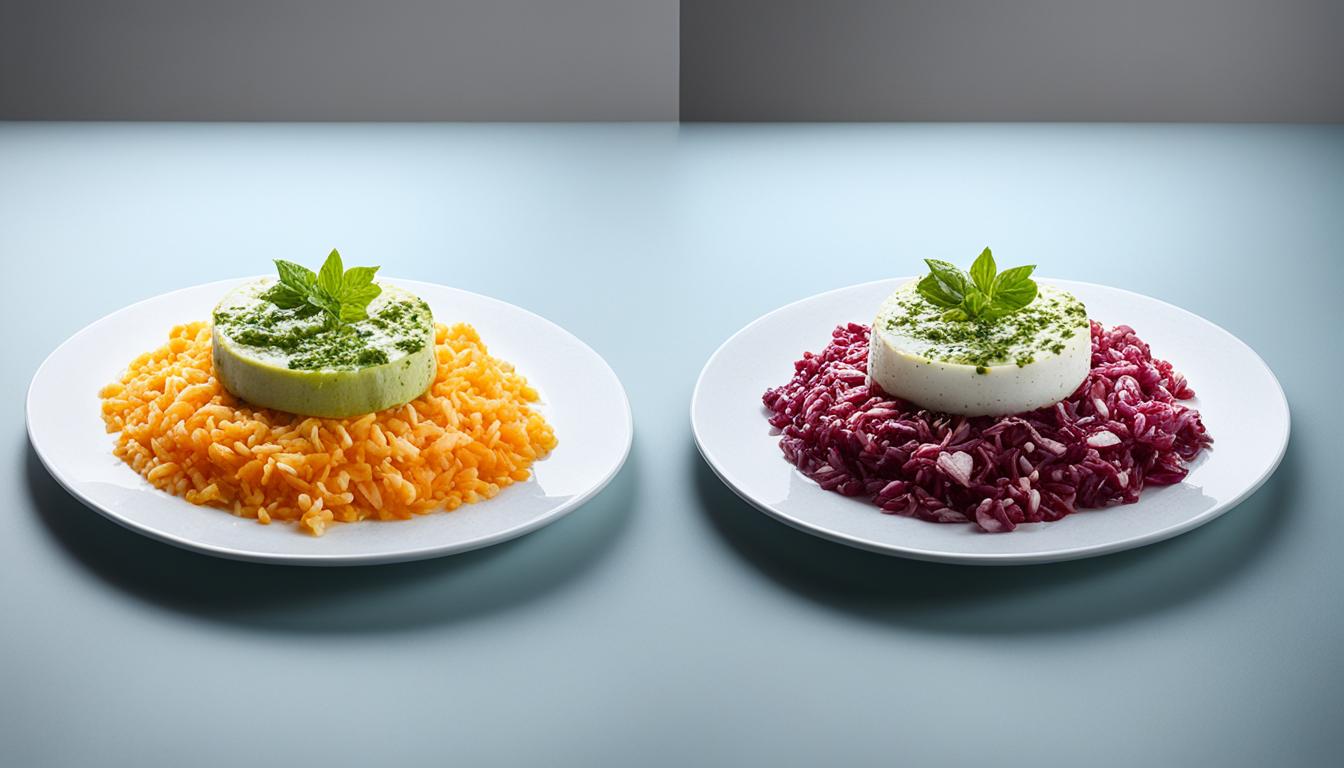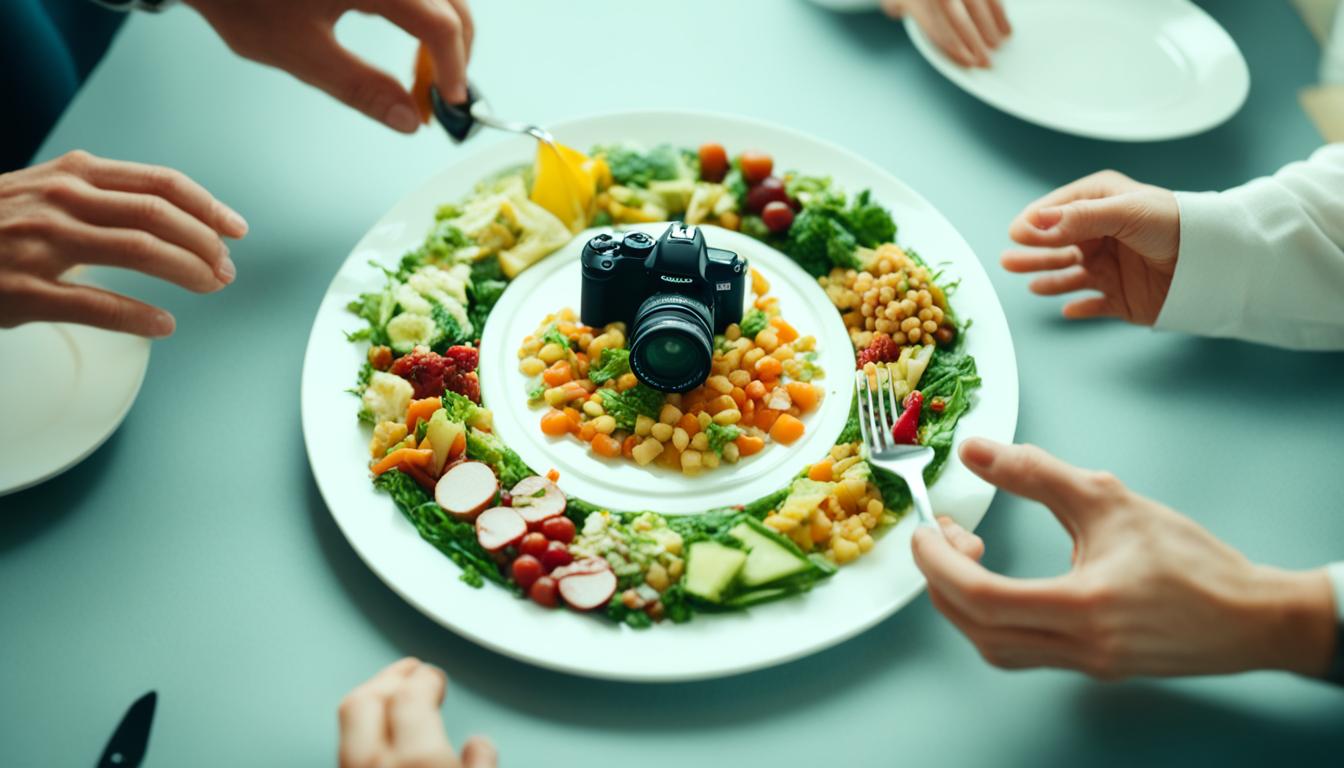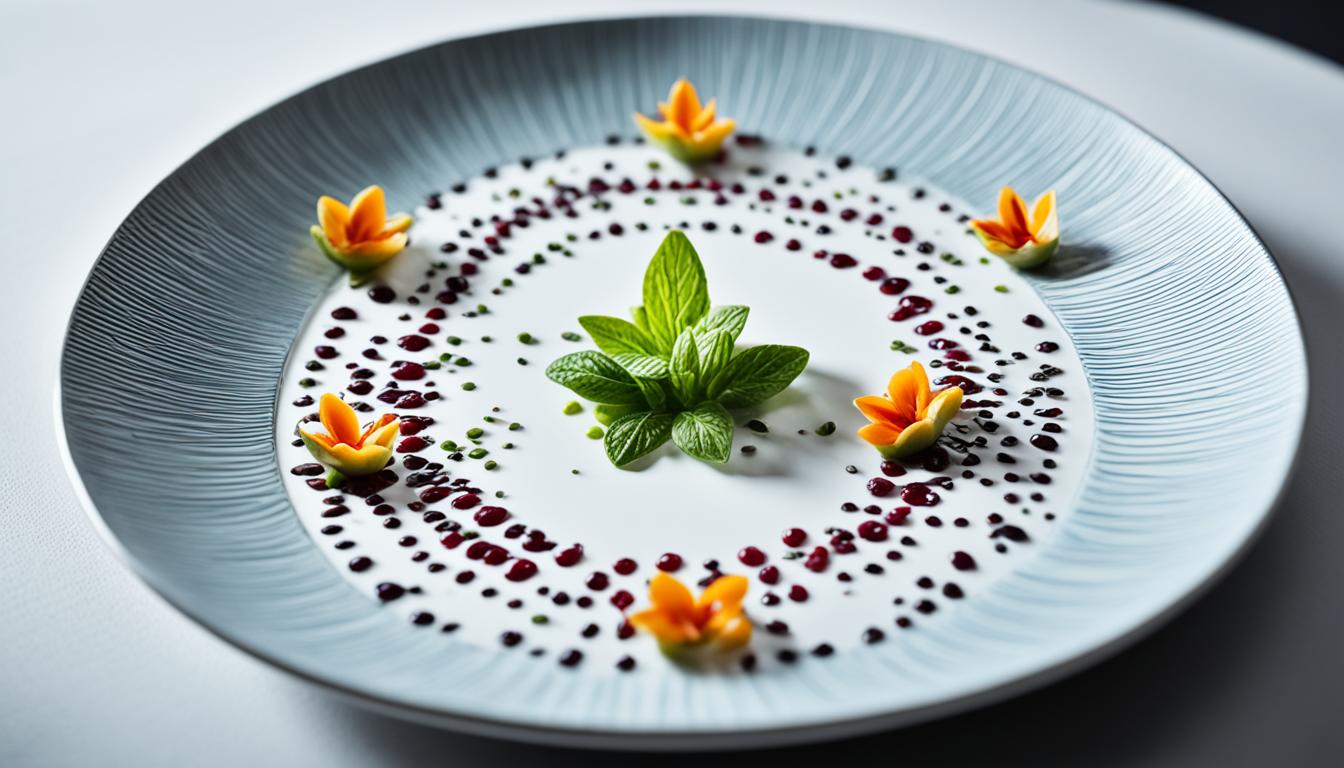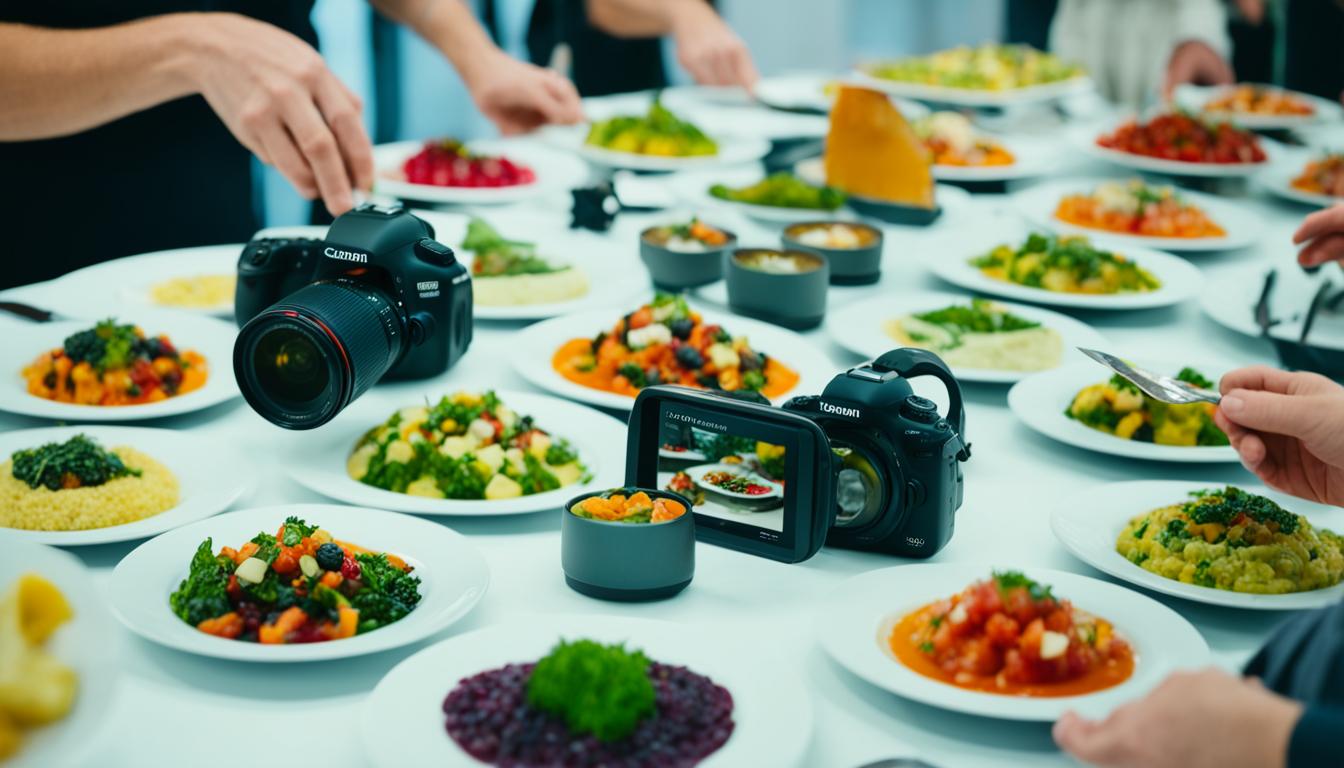Welcome to our guide on the fascinating debate between natural light and artificial light in food photography. As food photographers, we understand the importance of lighting in capturing the perfect shot. In this article, we will explore the qualities and benefits of both natural and artificial light, helping you make an informed decision for your food photography endeavors.
When it comes to food photography, lighting plays a crucial role in highlighting the colors, textures, and details of the dish. The choice between natural and artificial light can greatly influence the overall mood and aesthetic of the image.
Key Takeaways:
- Natural light and artificial light both have their advantages and should be considered based on the desired end result.
- Natural light offers a soft and diffused look, while artificial light provides control and consistency.
- Understanding the qualities of both types of lighting is essential in determining the best lighting for food photography.
- Transitioning from natural light to artificial light may require practice and experimentation, but it can offer greater creative possibilities.
- Consider the availability of natural light, your creative style, and the level of control you desire when choosing between natural and artificial light.
Benefits of Natural Light in Food Photography
When it comes to food photography, natural light is a game-changer. Not only does it produce stunning images, but it also offers a range of benefits that can elevate your photographs to another level. Here are some of the advantages of using natural light in food photography:
- Punchy Colors: Natural light enhances the vibrancy of food colors, making them appear more appetizing and inviting.
- Clearly Defined Shadows: The play of light and shadow created by natural light adds depth and dimension to your food images, making them visually captivating.
- Soft and Flattering Look: Natural light creates a soft and diffuse glow, which gives your dishes a natural and appealing appearance.
Moreover, natural light contributes to the authenticity of your food photography, allowing the textures and details of the dishes to shine through. It also helps capture the true essence of the food, making viewers feel like they can almost taste it.
Another advantage of natural light is its accessibility and convenience. Unlike artificial lighting setups that require equipment and technical know-how, natural light is readily available and free. All you need is a well-lit space, such as a window, and you’re all set to capture beautiful images.
However, it’s important to consider the time of day and weather conditions when shooting with natural light. The quality and intensity of natural light can vary throughout the day and change depending on the weather. By planning your shoots accordingly, you can ensure that you achieve the desired lighting effect for your food photography.
| Benefits of Natural Light in Food Photography | Examples |
|---|---|
| Punchy Colors | Fiery red tomatoes, vibrant green herbs, and golden brown pastries. |
| Clearly Defined Shadows | Moody shadows that add depth to the composition of a dish. |
| Soft and Flattering Look | Dreamy lighting that creates a romantic and inviting atmosphere. |
Table: Examples of the benefits of natural light in food photography
Advantages of Artificial Light in Food Photography
While natural light has its advantages, artificial light also offers significant benefits for food photographers. One of the key advantages of using artificial light is the ability to have complete control over the lighting setup. We can adjust the strength, direction, and quality of the light to achieve our desired look.
Professional food photography lighting techniques, such as using diffusers or reflectors, can help create soft and diffused light similar to natural light. By manipulating these techniques, we can enhance the texture, colors, and overall presentation of the food.
Additionally, artificial light provides consistency in color temperature and brightness, making post-processing and editing much easier. We can achieve consistent results across multiple shots and ensure that the food looks consistent throughout the photography session.
Another advantage of artificial light is its versatility. We can create unique and dramatic lighting effects that are difficult to achieve with natural light alone. By skillfully shaping and positioning the artificial light, we can highlight specific areas of the food, create interesting shadows, and play with different lighting angles. This allows us to add a creative touch to our food photography and make it stand out.
For indoor food photography, artificial light is especially beneficial. In indoor settings where natural light may be limited or inconsistent, artificial light provides a reliable and consistent source of illumination. We can shoot anytime, regardless of the time of day or weather conditions, ensuring that we have complete control over our photography environment.
If you’re just getting started with artificial light in food photography, don’t worry. It may take some practice and experimentation to master the techniques, but the results can be truly rewarding. With careful planning and attention to detail, artificial lighting can elevate the quality of your food photography and help you achieve professional-looking shots with ease.

Comparison of Natural Light and Artificial Light in Food Photography
| Natural Light | Artificial Light |
|---|---|
| Diffused and soft lighting | Adjustable strength, direction, and quality of light |
| Punchy colors and defined shadows | Consistency in color temperature and brightness |
| Authentic and natural feel | Versatility for creating unique and dramatic lighting effects |
| Dependent on weather conditions and time of day | Reliable and consistent in indoor settings |
Tips for Using Natural Light in Food Photography
When it comes to capturing stunning images of food, natural light can be a game changer. Here are some tips to help you make the most of natural light in your food photography:
- Consider your creative vision: Before starting your shoot, think about the overall look and feel you want to achieve. Natural light can create punchy colors and defined shadows, so taking advantage of direct sunlight on a cloudless day can yield striking results.
- Embrace diffused light: Cloudy or overcast days can provide diffused light, perfect for achieving a soft and low contrast aesthetic. If you’re shooting on a sunny day and want to soften the light, you can use shoot-through reflectors or even sheer curtains to mimic the effect of diffused light.
- Plan your shoot around lighting conditions: Understanding lighting patterns throughout the day can help you schedule your shoot for the best natural light. During the blue hour or golden hours, when the sun is low in the sky, light tends to have a warm, golden quality. While this can create a beautiful ambiance, it may distort the natural colors of the food, so it’s best to avoid shooting during these times.
Incorporating these tips into your natural light photography can elevate your food images and bring out their true beauty. Remember to experiment and have fun with the process.
Why Natural Light?
“Natural light can bring out the vibrant colors and textures of food in the most authentic way. It adds a natural warmth and enhances the details, making the food look enticing and appetizing.” – Jane Smith, Food Photographer
Transitioning to Artificial Light in Food Photography
Transitioning from natural light to artificial light in food photography may seem intimidating at first, but it offers several advantages.
Artificial lighting provides consistency in temperature and brightness, making the editing process more efficient. It allows for greater control and manipulation of the light to achieve specific lighting effects.
To make artificial light look natural, it is important to understand the qualities of natural light and replicate them with the use of suitable equipment.
Artificial lighting options range from flash to continuous light, with the latter offering the ability to see the light on the food at all times.
Setting up artificial lighting involves choosing the right equipment, such as a daylight balanced LED continuous video light and a large softbox for diffusion. Positioning and adjusting the light to mimic the characteristics of natural light can help create natural-looking artificial lighting setups.

Tips for Transitioning to Artificial Light in Food Photography:
- Start by experimenting with different artificial lighting equipment to find what works best for you.
- Invest in a daylight balanced LED continuous video light for consistent and natural-looking lighting.
- Use a large softbox to diffuse the light and avoid harsh shadows.
- Position the light at an angle to mimic the direction of natural light.
- Adjust the brightness and temperature of the artificial light to match the desired mood and style of your photos.
Conclusion
In conclusion, both natural light and artificial light have their advantages when it comes to food photography. Natural light offers a soft and diffused look, creating a natural and authentic feel in the images. On the other hand, artificial light provides photographers with control and consistency, allowing them to manipulate the lighting setup to achieve specific effects.
When deciding between natural and artificial light, it is important to consider the desired creative style, the availability of natural light, and personal preference. Understanding the characteristics of both types of lighting is key to replicating the natural light look with artificial light.
While transitioning from natural light to artificial light may require some experimentation and adjustment, the benefits of increased control and consistency make it a worthwhile endeavor for many food photographers. By choosing the right equipment and positioning the artificial light to mimic the qualities of natural light, photographers can achieve stunning results.
To sum up, whether you prefer the softness of natural light or the control of artificial light, knowing how to work with both types of lighting can provide you with a range of options to create beautiful food photography. So experiment, explore, and find the lighting techniques that best suit your style and vision.
FAQ
What are the benefits of natural light in food photography?
Natural light in food photography offers punchy colors, clearly defined shadows, and an overall soft and flattering look. It creates a natural and authentic feel and is readily available at no cost.
What are the advantages of artificial light in food photography?
Artificial light provides complete control over the lighting setup, allowing photographers to adjust the strength, direction, and quality of the light. It offers consistency in color temperature and brightness, making post-processing easier and enabling photographers to create unique and dramatic lighting effects.
What tips are there for using natural light in food photography?
When using natural light, consider the time of day and weather conditions. Direct sunlight on a cloudless day produces punchy colors and defined shadows, while diffuse light can be achieved on cloudy or overcast days for a soft and low contrast look. Avoid shooting during the blue hour or golden hours to prevent distorting the natural colors of the food.
How can I transition from natural light to artificial light in food photography?
Transitioning to artificial light requires understanding the qualities of natural light and replicating them with suitable equipment. Choose the right equipment, such as a daylight balanced LED continuous video light and a large softbox for diffusion. Position and adjust the light to mimic the characteristics of natural light for a natural-looking artificial lighting setup.
What is the conclusion about natural vs. artificial light in food photography?
Both natural light and artificial light have their advantages for food photography. Natural light offers a soft and diffused look, while artificial light provides control and consistency. Choosing between the two depends on the desired creative style, availability of natural light, and photographer’s preference.
How Does Color Theory Impact the Use of Natural and Artificial Light in Food Photography?
When it comes to food photography, understanding color theory in food photography is crucial for utilizing natural and artificial light effectively. The selection of lighting can greatly influence how colors appear in the final image, affecting the overall aesthetics and visual appeal of the food.




